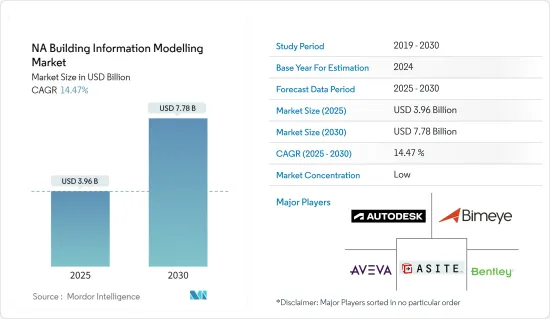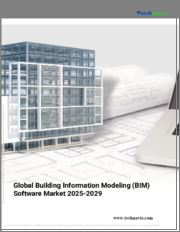
|
시장보고서
상품코드
1640325
북미의 빌딩 정보 모델링 : 시장 점유율 분석, 산업 동향 및 통계, 성장 예측(2025-2030년)NA Building Information Modelling - Market Share Analysis, Industry Trends & Statistics, Growth Forecasts (2025 - 2030) |
||||||
북미의 빌딩 정보 모델링(BIM) 시장 규모는 2025년에 39억 6,000만 달러로 추정되며, 예측 기간(2025-2030년) 동안 14.47%의 CAGR로 2030년에는 77억 8,000만 달러에 달할 것으로 예상됩니다.

BIM 솔루션에 대한 수요는 부분적으로 해당 지역의 건설 활동에 따라 달라집니다. 미국에서는 경기 침체 이후 건설업이 크게 회복되어 경제의 주요 부문 중 하나로 부상하고 있습니다. 미국은 BIM 솔루션의 초기 도입 국가 중 하나이며, 일반 사업청은 BIM 솔루션의 이용을 촉진하기 위해 몇 가지 적극적인 조치를 취하고 있습니다.
주요 하이라이트
- BIM의 활용은 이 기술과 관련된 수많은 장점으로 인해 AEC 산업에서 보편화되었습니다. 분절된 납품 방법, 건축 문제, 다양한 이해관계자들로 인해 현대의 AEC 비즈니스는 복잡하며, BIM의 보급을 가능하게 하고 있습니다. 이는 주로 AEC 산업에서 BIM 채택에 관한 정부 법률의 성장과 업무 효율성을 향상시키기 위해 건설 부문에서 자동화 모델의 필요성이 높아졌기 때문입니다.
- 빌딩 정보 모델링(BIM)은 종이 기반 설계, 모델링, CAD 시스템과 같은 기존 도구에 비해 장점이 많아 채택이 증가하고 있으며, BIM은 주로 건축물의 모든 구성요소와 구조를 포함한 정확하고 정밀한 기하학적 가상 모델을 쉽게 생성할 수 있습니다. 쉽게 만들 수 있습니다.
- BIM 기술은 많은 정부 규제가 다양한 지역 시장에서 BIM 솔루션의 사용을 촉진하고 있기 때문에 성장이 예상됩니다. 또한, 효율적인 모델링 시스템으로 인해 많은 지역의 민간 기관들이 BIM으로 전환하고 있어 시장 성장을 촉진하고 있습니다.
- 그러나 고가의 소프트웨어, 제한된 훈련된 전문가, 구현 문제 등이 시장 성장을 저해할 수 있습니다.
- COVID-19 팬데믹은 미국과 캐나다를 포함한 여러 국가의 장기적인 봉쇄로 인해 진행 중인 건설 프로젝트를 중단시켰습니다. 사람들은 정부가 정한 안전 규칙을 지키기 위해 재택근무를 해야 했습니다. 이는 건설에 BIM을 사용할 수 있는 새로운 기회를 가져왔습니다. 건설 프로젝트에서 BIM 사용의 특징과 이점에 대한 인식이 높아짐에 따라 건설 시장에서 BIM의 성장이 촉진될 것으로 예상됩니다.
북미의 BIM(빌딩 정보 모델링) 시장 동향
상업용 애플리케이션 부문이 큰 시장 점유율을 차지
- 북미의 계약자 등 BIM의 상업적 사용자들은 다른 지역의 사용자들보다 BIM 솔루션을 훨씬 더 많이 사용하고 있습니다. 상업 부문에 대한 투자는 주로 BIM의 활용도를 높이는 데 초점을 맞추고 있습니다. 소프트웨어 소유자와 최종 설계 대상인 최종사용자와의 협업을 통해 프로세스 성과를 개선하고 오류와 누락을 줄일 수 있습니다.
- 북미에서는 BIM이 특히 시설 및 정부 건축 프로젝트에서 많이 사용되고 있습니다. 캐나다에서는 BIM이 인프라 프로젝트에서 더 많이 사용되고 있습니다.
- 상업용 개발업체는 건설 전에 건물의 세부적인 표현을 제공함으로써 영업 활동에서 BIM의 3D 시각화 기능의 이점을 누리고 있습니다.
- 소비자는 건설 전에 건물의 완성된 모델을 시각화할 수 있기 때문에 고객과 상업시설 모두에게 상호 이익이 됩니다. 상업시설은 모든 과정이 완료되기 훨씬 전에 구매자를 찾을 수 있습니다.
- 북미에서는 급속한 개선과 기술 개발이 진행되고 있습니다. 이에 따라 많은 사람들이 대도시로 이주하기 시작했습니다. 도시 지역의 상업적 및 개인적 요구 사항에 대한 향상된 인프라에 대한 수요가 급증하면서 향후 몇 년 동안 BIM 시장의 성장을 촉진할 것으로 예상됩니다.
미국이 주요 시장 점유율을 차지할 것으로 예상
- 최신 기술 발전에 집중하는 기업들은 미국 전역의 도시 인구 급증과 정부 투자 증가와 같은 중요한 시장 특성으로부터 큰 이익을 얻을 수 있을 것으로 예상됩니다.
- 지난 몇 년 동안 BIM은 미국 엔지니어링 및 건설 부문에서 중요한 도구가 되었습니다. 이는 건설 프로젝트에 대한 민간 투자의 증가와 미국 정부가 인프라 개발을 촉진하려는 노력에 기인합니다. 정보 모델 개발을 전문으로 하는 개발 사업자는 공간 정보 과학과 연계된 지능형 3D 모델 기반 절차가 필요합니다.
- GIS 산업은 3D 모델링으로의 전환과 함께 점점 더 파괴되고 있으며, GIS와 BIM을 하나의 전체 환경으로 통합하는 이러한 발전은 설계 및 건설 산업이 2D에서 3D BIM으로 전환하는 변화를 보여주고 있습니다.
- 이 지역에는 중요한 BIM 벤더가 존재하며, BIM은 지리정보 시스템과 같은 다른 트렌드와 자주 통합되고 있습니다. 캘리포니아에 본사를 둔 신생 기업 Katerra는 BIM 도구와 계산 설계를 ERP 세계 공급망 인프라에 직접 통합하여 상품 주문, 제조, 추적, 배송을 용이하게 하는 통합 플랫폼을 구축했습니다.
- 미국 인구조사국에 따르면, 미국의 민간 건설 지출은 지난해에도 성장세를 이어가며 공공부문 건설 지출의 약 4배에 달했습니다. 미국 50개 주 내 건설 지출을 보면 텍사스와 캘리포니아가 상위권을 차지하고 있습니다. 예측에 따르면 미국의 건설 지출액은 앞으로도 계속 증가할 것으로 예상됩니다.
북미의 빌딩 정보 모델링(BIM) 산업 개요
북미의 빌딩 정보 모델링 시장은 Autodesk, Inc., Asite Solutions Ltd., Aveva Group PLC, Bentley Systems Inc., Bimeye Inc. 등의 주요 기업들이 존재하며 세분화되어 있습니다. 이 시장에 진입한 기업들은 제품 라인업을 강화하고 지속가능한 경쟁 우위를 확보하기 위해 제휴 및 인수 등의 전략을 채택하고 있습니다.
- 2023년 5월, 미국에 본사를 둔 작업장 관리 소프트웨어 개발 기업 Eptura는 통합 작업장 관리 시스템 Archibus의 새로운 업데이트를 발표했습니다. 이번 업데이트는 Archibus의 BIM(Building Information Modeling) 뷰어 도구에 새로운 기능을 추가하여 건설 후 팀이 건물을 효율적으로 관리할 수 있도록 지원합니다. Archibus의 BIM 뷰어의 최근 개선된 기능은 데이터 흐름을 간소화하고, 시설 관리자가 원하는 건물 모델을 보다 효과적으로 제어할 수 있도록 도와줍니다. 제어할 수 있게 되었습니다.
- 2023년 1월, 스냅트루드(Snaptrude)는 건축 설계 부문에서 Autodesk를 파괴하려는 스타트업으로, 보다 저렴한 비용으로 고객을 위한 현대적이고 광범위한 기능 세트를 발표했습니다. 뉴욕에 본사를 둔 이 회사는 수천 명의 고객을 확보했으며, 현재 시드 펀딩을 진행 중입니다. Snaptrude는 3D로 건물을 설계할 수 있는 협업을 제공하고, 비용, 기후, 에너지 이용률에 대한 건설 규모의 변화에 따른 영향을 알려주는 실시간 데이터를 생성 합니다.
기타 혜택
- 엑셀 형식의 시장 예측(ME) 시트
- 3개월 애널리스트 지원
목차
제1장 소개
- 조사 가정과 시장 정의
- 조사 범위
제2장 조사 방법
제3장 주요 요약
제4장 시장 인사이트
- 시장 개요
- 산업의 매력 - Porter's Five Forces 분석
- 공급 기업의 교섭력
- 소비자의 협상력
- 신규 참여업체의 위협
- 대체품의 위협
- 경쟁 기업 간의 경쟁 관계
- 밸류체인/공급망 분석
- COVID-19의 산업에 대한 영향 평가
제5장 시장 역학
- 시장 성장 촉진요인
- 주요 국제 시장의 BIM 이용을 촉진하는 정부 의무화
- 프로젝트 퍼포먼스와 생산성 향상
- 시장 성장 억제요인
- 비용과 구현 문제
- 시장 기회
- 스마트 시티와 그린 시티 채용 증가
제6장 시장 세분화
- 유형별
- 소프트웨어
- 서비스
- 도입 방식별
- 온프레미스
- 클라우드
- 용도별
- 상업
- 주택
- 산업
- 국가별
- 미국
- 캐나다
제7장 경쟁 구도
- 기업 개요
- Autodesk, Inc.
- Asite Solutions Ltd
- Aveva Group PLC
- Bentley Systems Inc.
- Bimeye Inc.
- Clearedge3D Inc.
- Dassault Systems SA
- Hexagon AB
- Nemetschek SE
- Rib Software AG
- Topcon Positioning Systems Inc.
- Trimble Inc.
제8장 투자 분석
제9장 시장 전망
ksm 25.02.10The NA Building Information Modelling Market size is estimated at USD 3.96 billion in 2025, and is expected to reach USD 7.78 billion by 2030, at a CAGR of 14.47% during the forecast period (2025-2030).

The demand for BIM solutions partly depends on the construction activity witnessed in a region. In the US, it has recovered significantly after the economic recession to emerge as one of the major sectors of the economy. The US has been one of the early adopters of BIM solutions, with the general services administration taking several proactive measures to promote the usage of BIM solutions.
Key Highlights
- The usage of BIM has become more common in the AEC industry due to the numerous benefits connected with this technology. Because of the fragmented delivery methods, building problems, and various parties involved, the contemporary AEC business is complicated, allowing for the widespread use of BIM. This is mostly due to a growth in government laws about BIM adoption in the AEC industry and the growing need for automated models in the construction arena to improve operational efficiencies.
- Building information modeling (BIM) has witnessed an increased adoption owing to its advantages over the existing tools, such as paper-based design and modeling and CAD systems. BIM primarily facilitates the users to create an accurate, precise, geometric virtual model with all the components and structures involved in the building.
- BIM technology is expected to grow as many government regulations promote using BIM solutions in various regional markets. Moreover, many regional private organizations are increasingly moving toward BIM, owing to its efficient modeling systems, thus driving market growth.
- However, high-cost software, limited trained professionals, and implementation issues might hamper the market's growth.
- The COVID-19 pandemic had shut down ongoing construction projects owing to the prolonged lockdown in countries including the United States and Canada. People were forced to work from home to maintain safety rules posed by the government. This opened new opportunities for the use of BIM in construction. Increasing awareness regarding the features and benefits of using BIM in construction projects was expected to boost the growth of BIM in the construction market.
North America Building Information Modelling (BIM) Market Trends
Commercial Application Segment Holds Significant Market Share
- Commercial users of BIM in North America, such as contractors, are far more advanced in using BIM solutions than users in other parts of the world in the same segment. Investments in the commercial segment are majorly directed toward increasing the depth of use of BIM. Collaborations between software owners and the intended end users of the finalized design can achieve improved process outcomes and reduce errors and omissions.
- In North America, BIM is used in projects, especially institutional and government building projects. In Canada, the use of BIM is more in infrastructure projects.
- Commercial developers have enjoyed the benefits of the 3D visualization feature of BIM in their sales efforts by offering a detailed representation of the building before construction.
- This can be mutually advantageous to both customers and commercial establishments, as consumers can visualize the finished model of the building before construction. The commercial establishment can find takers much before the completion of the entire process.
- The North American region is experiencing rapid improvements and technological developments. Hence, many people have started shifting to metropolitan cities. The surging demand for enhanced infrastructure for commercial and personal requirements in urban areas would propel the BIM market growth in the upcoming years.
United States is Expected to Hold Major Market Share
- Businesses concentrating on the most recent technological advancements are expected to gain significantly from important market features such as a rapidly rising urban population and increased government investment across the United States.
- During the past several years, BIM has become an important tool in the engineering and construction sectors in the United States. It results from increased private investment in construction projects and the U.S. government's attempts to boost infrastructure development. Businesses specializing in developing information models require intelligent 3D model-based procedures linked with spatial information sciences.
- The GIS industry is increasingly being disrupted as it transitions to 3D modeling. The progression, which demonstrates the integration of GIS and BIM into a single holistic environment, demonstrates the shift the design and construction industry is going through as it moves from 2D to 3D BIM.
- Significant BIM vendors are located in this area, and BIM is frequently integrated with other trends, such as geographic information systems. Katerra, a California-based startup, has built an integrated platform that directly integrates BIM tools and computational design to its ERP global supply chain infrastructure to make ordering, manufacturing, tracking, and delivery of goods easier.
- According to U.S. Census Bureau, United States spending on private construction continued to grow last year and was nearly four times larger than construction spending in the public sector. Texas and California were at the top of the ranking when observing construction spending within the 50 U.S. states. According to a forecast, the value of United States construction put in place is expected to keep growing during the following years.
North America Building Information Modelling (BIM) Industry Overview
North America Building Information Modeling Market is fragmented with the presence of major players like Autodesk, Inc., Asite Solutions Ltd, Aveva Group PLC, Bentley Systems Inc., and Bimeye Inc. Players in the market are adopting strategies such as partnerships and acquisitions to enhance their product offerings and gain sustainable competitive advantage.
- May 2023: Eptura, a United States based work technology company that develops software to manage workplaces introduced new updates to its integrated workplace management system, Archibus. The enhancements provide new capabilities in Archibus's BIM (Building Information Modeling) viewer tool, to enable the post-construction teams to manage their buildings efficiently. This makes the solution crucial for data to transfer smoothly from construction to post-building operators. The recent improvements to Archibus's BIM Viewer streamline the data flow and offers facility managers more control over their preferred building models.
- January 2023: Snaptrude, a startup, attempting to disrupt Autodesk in the building design space, announced its modern and broader sets of features for customers at a more affordable cost. The New York City-headquartered firm has gained thousands of customers and now, a seed funding. Snaptrude offers collaboration for designing buildings in 3D and it also generates real-time data to inform about the impact of changing construction size on cost, climate and energy utilization.
Additional Benefits:
- The market estimate (ME) sheet in Excel format
- 3 months of analyst support
TABLE OF CONTENTS
1 INTRODUCTION
- 1.1 Study Assumptions and Market Definition
- 1.2 Scope of the Study
2 RESEARCH METHODOLOGY
3 EXECUTIVE SUMMARY
4 MARKET INSIGHTS
- 4.1 Market Overview
- 4.2 Industry Attractiveness - Porter's Five Forces Analysis
- 4.2.1 Bargaining Power of Suppliers
- 4.2.2 Bargaining Power of Consumers
- 4.2.3 Threat of New Entrants
- 4.2.4 Threat of Substitutes
- 4.2.5 Intensity of Competitive Rivalry
- 4.3 Value Chain / Supply Chain Analysis
- 4.4 Assessment of COVID-19 Impact on the Industry
5 MARKET DYNAMICS
- 5.1 Market Drivers
- 5.1.1 Government Mandates Promoting the Usage of BIM in Key International Markets
- 5.1.2 Increased Project Performance and Productivity
- 5.2 Market Restraints
- 5.2.1 Cost and Implementation Issues
- 5.3 Market Opportunities
- 5.3.1 Increasing Adoption of Smart and Green Cities
6 MARKET SEGMENTATION
- 6.1 By Type
- 6.1.1 Software
- 6.1.2 Services
- 6.2 By Deployment Type
- 6.2.1 On-premise
- 6.2.2 Cloud
- 6.3 By Application
- 6.3.1 Commercial
- 6.3.2 Residential
- 6.3.3 Industrial
- 6.4 By Country
- 6.4.1 United States
- 6.4.2 Canada
7 COMPETITIVE LANDSCAPE
- 7.1 Company Profiles
- 7.1.1 Autodesk, Inc.
- 7.1.2 Asite Solutions Ltd
- 7.1.3 Aveva Group PLC
- 7.1.4 Bentley Systems Inc.
- 7.1.5 Bimeye Inc.
- 7.1.6 Clearedge3D Inc.
- 7.1.7 Dassault Systems SA
- 7.1.8 Hexagon AB
- 7.1.9 Nemetschek SE
- 7.1.10 Rib Software AG
- 7.1.11 Topcon Positioning Systems Inc.
- 7.1.12 Trimble Inc.



















